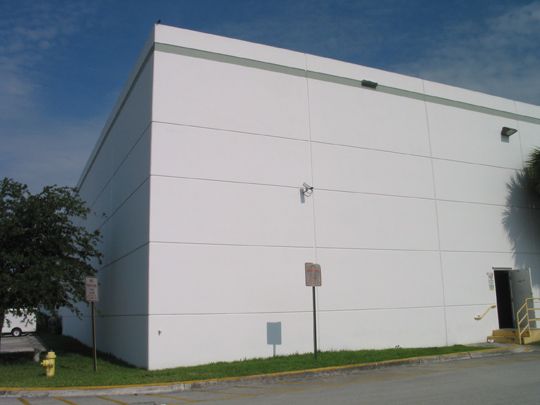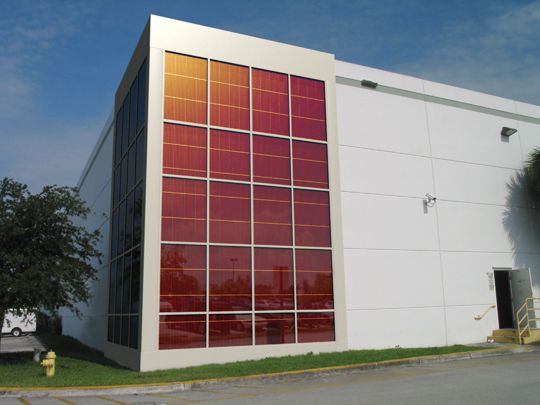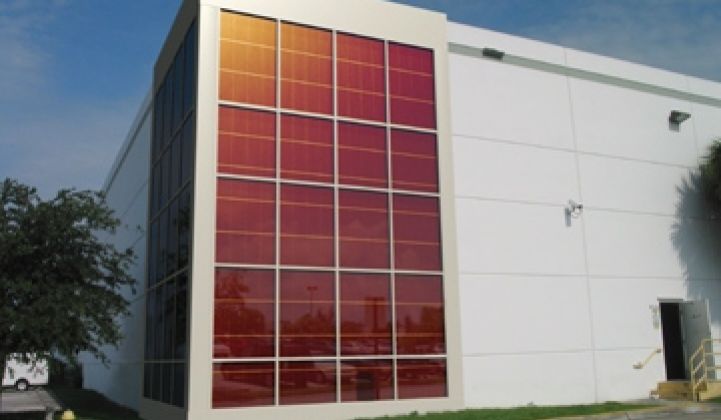Konarka Technologies and Arch Aluminum & Glass plan to erect two walls of solar panels in a pilot project to gather data for architects and other customers interested in integrating solar cells into building materials.
Glass panels encased with Konarka's organic solar cells will go up against the south- and east-facing walls of an existing Arch office building in Tamarac, Fla., by the end of the year, Konarka said Tuesday. Each solar panel will have a peak power output of 48 watts, and the entire setup with will have 1.5 kilowatts of generation capacity.
For the pilot project, the solar panels are set alongside the building. But for the commercial products that Konarka and Arch want to develop, the solar panels would become the "curtain walls," or building façade, said Terri Jordan, vice president of business development at Lowell, Mass.-based Konarka.
"This pilot installation will be used as a living laboratory," Jordan said. "We will be doing analysis on the levelized cost of energy to ensure that this will have a reasonable payback for customers."
In May this year, Konarka and Arch announced a product development plan to tackle the so-called "building integrated photovoltaic" (BIPV) market. The BIPV market is new, and skeptics abound.
Proponents say BIPV is a vast and untapped market, and embedding solar cells into materials and components for building construction is a logical extension of putting solar panels on rooftops.
Critics say the added costs of integrating solar cells and installing the solar panels and other electronic devices and wires necessary for electricity generation make the whole BIPV concept unfeasible. At least for now.
There also are costs and hassles with maintaining and replacing all these electrical equipment, which are likely to have a much shorter lifespan than the building itself.
The BIPV market opens up new opportunities for Konarka, which was founded in 2001 and struggled in early days to develop marketable commercial products. It has attracted more than $150 million in private investments and $20 million in government research grants since inception (see Konarka Gets $45M From Total).
The company began mass production of its Power Plastic films in October 2008 at a factory in New Bedford, Mass. Konarka has since announced sales agreements with makers of portable electronics and consumer products embedded with its solar cells, such as shoulder bags and café umbrellas.
Konarka develops organic solar films that use a polymer for converting light into electricity. The polymer is typically printed onto different types of flexible materials. Jordan declined to disclose the make-up of the polymer.
The limited efficiencies of organic solar cells make them less attractive to the conventional solar energy equipment market. Most of the solar panels today are made with silicon while some use alternative semiconductors to convert sunlight into electricity.
The most efficient silicon solar cell can convert 22 percent of the sunlight into electricity. Some other materials could reach more than 10 percent efficiencies.
Konarka has produced cells in its lab that could get to 6.4 percent. Lab results tend to be higher than what can be achieved in commercial production. Panels of Konarka's Power Plastic material has about 3 percent efficiency, Jordan said.
That 3 percent efficiency is what the company has achieved with its opaque red Power Plastic films, she added. The green version, which Konarka plans to roll out in January, should be able to get to 4 percent to 5 percent panel efficiency, Jordan said.
The company also plans to make these colorful films transparent next year. The company's researchers developed the transparent films only this year, and part of the development pact with Arch calls for Konarka to improve the performance of the transparent films, Jordan said.
Some architects prefer the glass façade to be transparent for aesthetic reasons, though the transparent films tend to have lower efficiencies, Jordan said. The company has surveyed architects about their color preferences.
"The architects we've spoken to in Europe and the U.S. tend to like the gray because it's neutral and the green because it's suggestive of green designs," Jordan said.
Konarka and Arch will experiment with panels with opaque and transparent films, as well as with different colors in their pilot project. Arch also will experiment with different glass designs.
Jordan declined to discuss manufacturing and installation costs, saying that the pilot project would provide the necessary data to determine those numbers.

The "before" image of the solar curtain wall.

A rendering of what the solar curtain wall will look like once installed.



